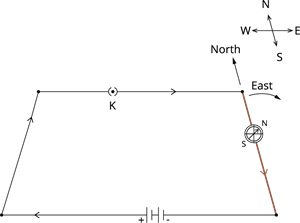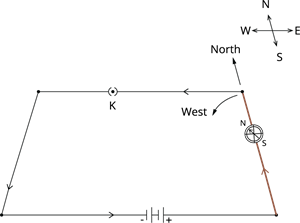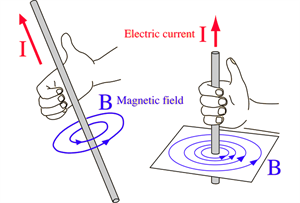PDF chapter test TRY NOW
In the previous section, we have discussed the basics of magnetic fields and performed an activity to prove that the electric current through a metallic conductor produces a magnetic field around it.
To find the direction of the field produced, let us repeat the activity in the following way,
To find the direction of the field produced, let us repeat the activity in the following way,
Steps:
- The following components are needed for this activity - Long straight copper wire, Two or three cells of 1.5 V each, and a plug key.
- Connect all the components in series, as shown in the below figure.

- Locate the straight wire parallel to and over a compass needle.
- Plug the key in the circuit.
- Note the direction of deflection of the north pole of the needle. As shown in the figure, if the current flows from north to south, the compass needle's north pole will move towards the east.
- Next, replace the cell connections in the circuit as shown in the below figure.

- This would result in the change of the current direction through the copper wire, that is, from south to north.
- Note the change in the direction of deflection of the needle.
You will see that now the needle moves in the opposite direction, that is, towards the west [see the figure]. It means that the direction of the magnetic field produced by the electric current is also reversed.
Observation:
The magnetic field created by an electric current is always oriented perpendicular to the direction of the current flow.
.

Magnetic field around a wire
The above diagram shows the magnetic field around a wire when the wire has a current flowing in it.
The central arrow represents the direction of the current in the conductor. The circles are field lines, and the arrows show their direction on the lines. Similar to electric field lines, the greater the number of lines (or the closer they are together) in an area, the stronger the magnetic field. If there is no current, there will be no magnetic field.
